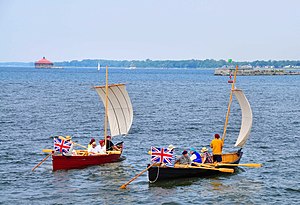
| |
| Class overview | |
|---|---|
| Builders | various |
| Operators | commercial and military freight haulers |
| In service | c. 1650 – c. 1850 |
| General characteristics | |
| Type | Bateau |
| Length | 24 to 50 ft (7.32 to 15.24 m) |
| Beam | 5 to 8 ft (1.52 to 2.44 m) |
| Draught | up to 1 ft (0.305 m) when loaded |
| Propulsion | setting poles, oars or sail |
| Speed | varied |
| Capacity | 1 to 2 tons |
| Complement | usually 3 or more |
| Armament | none |
| Notes | built to ferry freight on interior waterways of North America during the seventeenth and eighteenth centuries |
A bateau or batteau is a shallow-draft, flat-bottomed boat which was used extensively across North America, especially in the colonial period and in the fur trade. It was traditionally pointed at both ends but came in a wide variety of sizes. The name derives from the French word, bateau, which is simply the word for boat and the plural, bateaux, follows the French, an unusual construction for an English plural. In the southern United States, the term is still used to refer to flat-bottomed boats, including those elsewhere called jon boats.